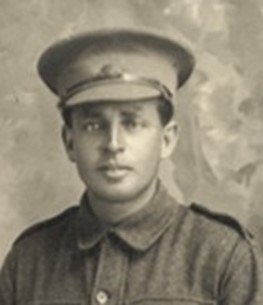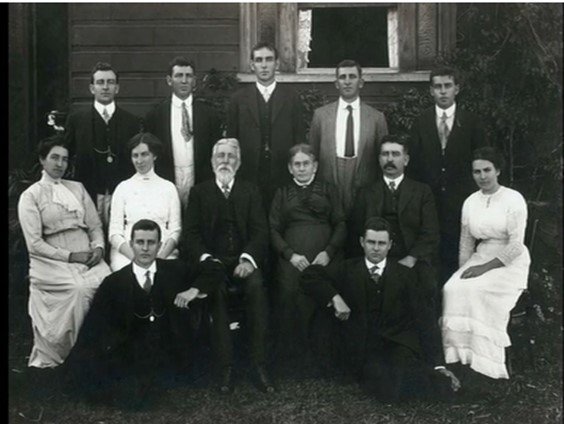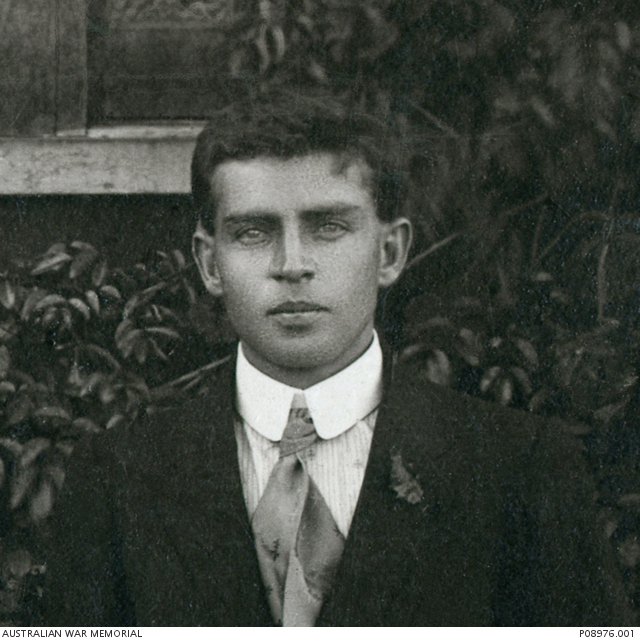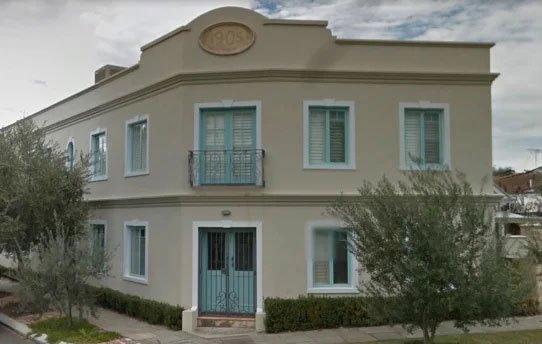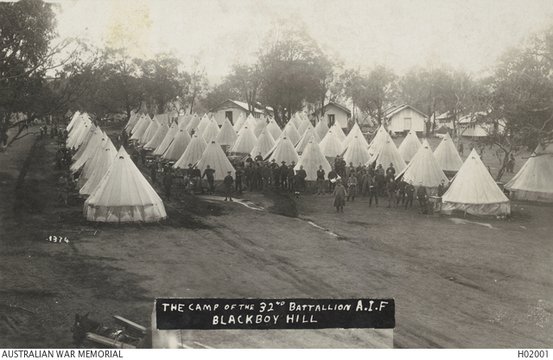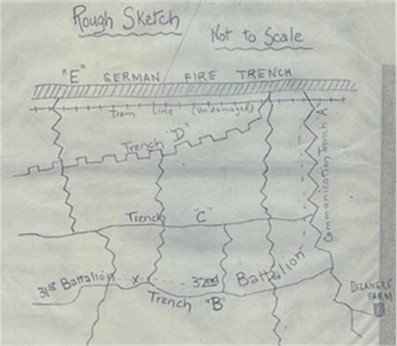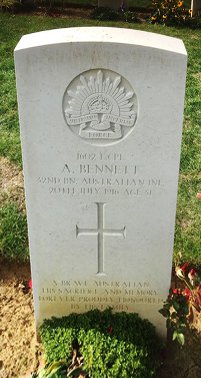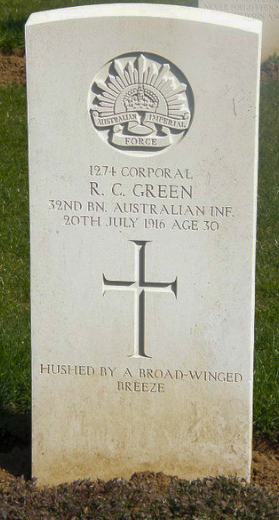Allan BENNETT
Eyes blue, Hair brown, Complexion fair
Early Life – Victoria and Western Australia
Allan Bennett was born on 6 July 1885 at Clunes, near Ballarat, Victoria. He was the 8th of 11 children (8 boys and 3 girls) of Henry Goulding Bennett and Fanny Bennett (nee Collier). Allan’s father was a mining engineer who was trained in England and was working on the mines at Clunes and Mount Egerton in the goldfields of Victoria during the late 1800’s. Henry married Welsh-born, Fanny Collier, in Russell’s Bridge near Geelong in 1871.
Allan attended Pleasant Street School on the banks of Lake Wendouree where the school’s motto was a prophetic “To Do My Duty”. He was a sportsman and excelled in swimming, running and football.
In 1898, when Allan was 13, his father took a job at the Cosmopolitan Gold Mine in Kookynie, some 700 kilometres east of Perth, so the family moved to Western Australia. While there, Allan began an apprenticeship as an ironmonger in the goldfields.
In about 1900, the family moved to Claremont, Perth where Henry built a large family home and named it Aberkenfig after Fanny’s birthplace in Glamorganshire, Wales. The Bennetts embraced life in Claremont, with the brothers joining the Claremont Swimming Club, winning races in national competitions, racing 18-foot yachts, running foot-races and playing football.
An Enterprising, Active Young Adult
After the move to Claremont, Allan trained in accountancy, finding his keen intelligence being well suited to business management. At twenty years old, he went into a partnership with two of his older brothers, Charles and Bert, and build Bennett Bros Grocers in Claremont. The distinctive building is now a private home.
In 1911, with Bennett Bros Grocers going strong, Allan made his way back to the Goldfields, but this time in a partnership with his sportsman friend Hugh Tompkins, and they established the Bennett & Tompkins general store in Kalgoorlie. The two were very well known for their successes both in business and on the football field.
Allan’s War - “To Do My Duty”
With war fever running high, three of the Bennett brothers enlisted. Allan’s oldest brother, Henry, in June 1915, Allan on 22 July 1915 and younger brother Harold just days afterwards. Private 1675 Henry Collier Bennett, aged 42, went into the Australian Army Medical Corps and Captain Harold Bruce Bennett, aged 26, served with the 51st Battalion. Both survived the war and returned to Australia.
Allan was assigned to the 1st Reinforcement, 32nd Battalion, D Company and did his training at Blackboy Hill, Western Australia. Here he met Robert Green, 29, a farmer from Toodyay, and they became fast friends. The soldiers’ initial training continued until the end of August and Allan was promoted to Corporal.
In late August, C and D companies departed WA to join the A and B Companies who had been formed in Adelaide. Further training continued and the full Battalion departed Australia on HMAT A2 Geelong on 18 November 1915, bound for Egypt. They arrived in Suez on 18 December.
The 32nd’s training continued in El Ferdan, Ismalia, Tel-el-Kebir, Ferry Post, Duntroon Plateau and Moascar. During their time in Egypt, they were inspected by H.R.H. Prince of Wales.
Having always been a sportsman and with the military training, Allan was in the prime of his life. While in Egypt, he ran into his old friend from Victoria and the Goldfields, 3rd Field Artillery Brigade Corporal Alf Fry, who wrote to his mother that Allan was:
`looking very fat and well…Soldiering evidently agrees with him.`
The Western Front – Straight into Battle
In mid-June, the call came to support the Western Front and they embarked from Alexandria on the ship Transylvania on 17 June 1916 to join the British Expeditionary Force. They arrived at Marseilles in France on the 23 June 1916.
They departed Marseilles by train, for the two-day trip to Hazebrouck, about 30 kilometers from Fleurbaix. They then settled into Morbecque and training continued with a focus on bayonet training and the use of gas masks.
D Company’s Lieutenant Sam Mills’ letters home were optimistic for the coming battle:
`We are not doing much work now, just enough to keep us fit—mostly route marching and helmet drill. We have our gas helmets and steel helmets, so we are prepared for anything. They are both very good, so a man is pretty safe.`
On 14 July, they moved into Fleurbaix and then were into the trenches on 16 July, just 11 months after Allan had enlisted.
On the 17th they were reconnoitering the trenches and cutting passages through the wires, preparing for their attack. D company got a short break in Fleurbaix on the afternoon of the 18th but were back in the trenches by 4:15pm on the 19th preparing for their attack. They were in position by 5:45 and the charges over the parapet began at 5:53pm.
Allan’s D Company was assigned to the third and fourth waves of the attack.
The 32nd Battalion was successful in their initial assaults, and by 6:30pm they were in control of the German’s first line system, which was noted as “practically a ditch with from 1 to 2 feet of mud and slush at the bottom”. However, by 8:30pm their left flank was under heavy bombardment with high explosives and shrapnel. Return bombardment support was provided and the troops were told that “the trenches were to be held at all costs”.
Fighting continued through the night. At 4am, the Germans began their attack from the Australian’s left flank and then on the front.
A charge at the Germans’ firing line was made by the Australians, but they were low on grenades and there was machine gun fire from behind from an emplacement at Delangre Farm. They were also so far advanced that they were getting shelled by both sides.
During their assault, Robert Green, Allan’s best friend from their time at Blackboy Hill, was badly wounded and fell into a shell crater. Allan, Lieutenant Sam Mills and a soldier named Brotrell ran to the aid of their fallen mate, but their retreat was cut off by a rain of artillery.
With nowhere else to go, they dragged Robert through no-man's-land towards the fighting. In their desperate dash, Allan was raked by machine gun fire. Despite his wounds, Allan managed to get himself and Robert into the unforgiving shelter of a captured enemy trench. They survived the night there, but as later reported by Sergeant Aubrey Sinclair, his condition was “very low”. This is the last known whereabouts of these two, as they were so far forward that stretcher bearers could not get through to them.
By 7:30am on 20 July, what was left of the 32nd had withdrawn back to their own lines. Allan and Robert were not with them. The toll the attack took on the 32nd was terrible – 718 casualties, 90% of their effective strength.
Lieutenant Sam Mills (see earlier news article reference) survived the battle. In his letters home, he recalls the bravery of the men of D Company:
`They came over the parapet like racehorses……… However, a man could ask nothing better, if he had to go, than to go in a charge like that, and they certainly did their job like heroes.`
He also specifically mentions Allan:
`Do you remember a store in Kalgoorlie, run by Bennet and Tonkins, in Graeme street, near Hare-street? Allan Bennett was with us, and behaved like the gallant lad he was.`
A Long Wait for the Family
There was a long, long wait for the family. They were notified in August 1916 that he was missing in battle. It was not until November that his name appeared on a list of the dead from the Germans but, as there was still some uncertainty about being a prisoner or being killed, it was not until 13 March 1917 that his identity disk was received. An ‘in the field’ court of enquiry finally declared him killed in action on 2 May 1917. His few belongings were returned to the family.
His final resting place, however, remained unknown.
Allan’s father, as next of kin, received on his son’s behalf the Victory Medal, the 1914-15 Star Medal, Memorial Scroll and King’s Message, British War medal and a Memorial Plaque. Allan has been commemorated at V. C. Corner in Fromelles, France and at the Australian War Memorial. In addition, his parents arranged for a memorial plaque in Christ Church, Claremont and there is a plaque at the Western Australian Botanical Gardens.
In the Roll of Honour circular, Henry Bennett, senior described his son in the following terms:
`In addition to being a very successful businessman, he was widely known in the sporting world for his sportsmanship, footballing, foot running, swimming, etc. He was a dutiful son, of strict morals and exemplary character.`
This testament to his son was fully exemplified by Allan’s honourable actions on the battlefield.
Closure - Pheasant Wood
In 2008, a mass grave that had been dug by the Germans outside of Fromelles was discovered. It contained the remains of some 250 soldiers.
With this discovery, there was an Australian Defence Force project to match up DNA of the soldiers in the grave with living relatives to be able to honour the soldiers properly. Allan’s remains were among those positively identified, as well as his mate Robert Green’s.
According to one 2010 news report Allan’s niece, Ms Judy Thomson said she had wept when she was told that Allan was among the dead. The family had hoped that DNA testing would reveal his final resting place so that he could be afforded the dignity he deserved:
`"Its just really sad knowing that my fathers brother was killed and buried en masse in an undignified way"`
A new cemetery was built in Fromelles to honour the soldiers. Several members from Allan’s family, along with hundreds of others, attended the dedication of the new cemetery on 19 July 2010.
Another article reported that Peter Thomson, Allan’s grandnephew, said that it was comforting to know that Allan and his mate, Robert Green, had remained united in death:
`"It was kind of moving really, because it was a story about mateship and loyalty, rather than running for safety, he helped his buddy. It is nice to think they had that continuing connection in death."`
As a fitting epilogue to a story of a brave man, also in attendance at the ceremony was Robert Green’s English grandniece, who was overcome with emotion when she discovered the Australians sitting next to her were Allan’s family, the man who died trying to save her great uncle.
The inscription on L/Cpl Allan Bennett’s headstone at Fromelles reads
A BRAVE AUSTRALIAN
HIS SACRIFICE AND MEMORY
FOREVER PROUDLY HONOURED BY HIS FAMILY
,The inscription on Cpl Robert Green’s headstone at Fromelles reads
HUSHED BY A BROAD WINGED BREEZE
The Fromelles Association would love to hear from you

Contacts
(Contact: carla@fromelles.info or geoffrey@fromelles.info).
(Contact: army.uwc@defence.gov.au or phone 1800 019 090).
Donations
If you are able, please contribute to the upkeep of this resource.
(Contact: bill@fromelles.info ).
